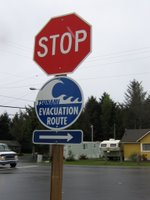 From the AP:
From the AP:
Murals of lynching stir debate - Legislature's move to Ada's courthouse could force decision on Indian murals
For 66 years, two murals depicting the lynching of an American Indian have hung in a now-abandoned county courthouse in Idaho's capital...
Starting in 2008, the Idaho Legislature plans to meet in the courthouse as its century-old Statehouse undergoes a $115 million revamp.
Historic preservationists say they'll fight attempts to remove the murals, products of the Works Progress Administration Artists Project... The 1940 works are part of the building, some historians say.
Still, Indian leaders and many lawmakers say turning the old Ada County Courthouse into Idaho's most public building, even temporarily, will force the state to confront the future of the murals, which one local judge in the 1990s found so offensive he draped an American flag over them.
I'm not sure how you'd go about leaving the murals uncovered and intact, short of placing a live docent in front of them and engaging passers-by (and legislators too) in a lively teaching moment about Idaho's Indian wars.
Here is a link to some pictures of the other courthouse murals (other than the mural showing the lynching).
Here is a previous news item about the murals.
Update: An earlier version of the AP article, titled "Monuments of intolerance," refers to the murals as "monuments to prevailing attitudes that once dominated the West." Later versions in the Denver Post and the Boston Globe modify this to "reminders of the bloodshed that accompanied America's westward expansion." I think this is more accurate. I think that it's possible to read the murals as a bit of New Deal - era culture jamming, a subversive artistic critique of lynching and anti-Indian bias, smuggled into a courthouse of all places, a bit like Diego Rivera painting a portrait of Lenin in a mural at Rockefeller Center.
To leave the murals up would require an imaginative work of curating and historiography beyond Arthur Hart's, I'm afraid. It would take more room than an explanatory paragraph on the front of each one. You'd want to interpret at least three threads of history:
1. the experience of American Indians in Idaho in the 19th Century, for instance, the Bear River Massacre which resulted in more victims than Wounded Knee, but whose historical record is obscured and contested
(compare this marker at the site and this marker, which speaks of "90 combatant women and children."), and see the undated monograph from the Idaho State Historical Society website, Battle (sic) of Bear River (pdf file), which crows, "This military action completed one of the most successful expeditions of the West against hostile Indians.... since the Cache Valley Shoshoni were wiped out, the settlers of Cache Valley were freed from further Indian difficulties...");
2. the ways that experience was represented and refracted in works of art such as WPA paintings in the 20th; and
3. how Indian people in Idaho interpret and portray both eras in the 21st.
It may be a better idea to bring down the curtain on the murals, at least in their present location. They're canvas - conceivably they could be moved to the state historical society. As a former visitor to that courthouse, I don't remember anyone revering the murals as monuments. Instead, people would point them out to others, scratch their heads, and say, "can you believe this?" (Or to be anachronistic, "WTF?") The cover-up by the American flag, symbolic as that sounds, was not controversial or unwelcome at the time. However, the story of how two generations of Boise lawyers walked past the murals up to that point without a bye-your-leave is a mini-history of its own, one I share. Yes, I was a history major, and I guess I'm still an Idahoan.









































